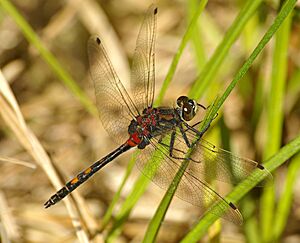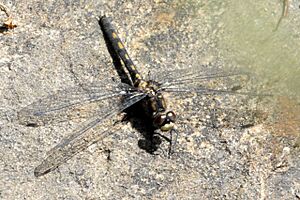White-faced darter facts for kids
Quick facts for kids White-faced darter |
|
|---|---|
 |
|
| Male | |
| Conservation status | |
| Scientific classification |
The white-faced darter (Leucorrhinia dubia) is a type of dragonfly. It belongs to a group called Leucorrhinia and is part of the Libellulidae family. You can spot it by its red and black patterns and a special white patch on its head.
These dragonflies live in wet places like wetlands and peat bogs. You can find them from northern Europe all the way east to Siberia. Adult white-faced darters are active from about April to September. This time is known as their "flight period." They lay their eggs in acidic water, often in clumps of sphagnum moss. This moss provides a safe home for their young, called larvae. Fish often eat these larvae, so you usually find them in lakes where there are no fish.
The IUCN Red List says the white-faced darter is a species of least concern. This means it's not currently in danger of disappearing. However, its homes can be destroyed by pollution or climate change.
Contents
What They Look Like
This dragonfly has a mostly black body. It is usually about 33 to 37 millimeters long. Its belly is 21 to 27 millimeters long, and its back wings are 23 to 28 millimeters long.
Grown-up males have bright red and orange marks on their bodies. These marks get darker as they get older. Young males and females have pale yellow marks instead. All white-faced darters have a clear white patch on the front of their heads. Their wings have a brown spot at the bottom and dark black spots called pterostigma.
Sometimes, people might confuse this dragonfly with others. These include the black darter, ruddy darter (Sympetrum sanguineum), and common darter (Sympetreum striolatum). But the white patch on its face usually helps you tell it apart.
Where They Live
This dragonfly lives across a wide area, from western Europe to Japan. You can often find it in western, northern, and eastern Europe, especially in higher places. But it is rare in southern Europe and the United Kingdom.
In recent years, people have seen this species as far away as Russia and China. However, most sightings are in central and northern Europe. In Britain, most white-faced darters live in the highlands of Scotland. Important groups are found in Inverness-shire and Ross-shire. In England, a few small groups live in Cheshire and Cumbria. Here, special plans help protect them. They are also found as far south as Chartley Moss National Nature Reserve in Staffordshire. Overall, the number of these dragonflies in Britain has gone down in the last 35 years.
Their Home Environment
Adult white-faced darters can use scrub and woodland areas to rest and find food. Their young, the larvae, need watery places on land. These include marshes, wetlands, and peat bogs. These places usually have plants growing at the water's edge.
Peat bogs are very important homes for them. They provide the acidic conditions that sphagnum moss needs to grow. This moss gives the dragonflies food and a safe place to hide.
Life Cycle
Growing Up: The Larval Stage
Like all dragonflies, the young white-faced darters, called larvae, grow by shedding their outer skin. This process is called moulting. They do this many times as they get bigger.
When they are very young, larvae like to live in sphagnum moss. This moss can trap tiny bits of food that would otherwise sink. So, it gives them a steady food source. Many animals, like fish, birds, amphibians, and other bugs, eat dragonfly larvae. The moss also gives them a safe place to hide from these predators.
Larvae can even change their color to match the moss they live in, whether it's brown or green. This helps them blend in and hide from predators. Sometimes, pollution makes ponds and lakes more acidic. This can actually help the white-faced darter. More acidic water means more sphagnum moss, which they love.
Larvae look for food day and night. But they catch more food during the night. They also sometimes eat other white-faced darter larvae. This happens especially if there isn't much other food, like tiny water animals called zooplankton. Other types of dragonflies can also eat them. Bigger larvae usually eat smaller ones. Scientists think this helps control how many dragonflies are in one place.
These larvae usually do not do well in places where fish live. They seem to be easier for fish to catch than other dragonfly species. This might be because they actively swim around to find food. This is different from some other dragonflies that just "sit and wait" for food.
White-faced darter larvae use their eyes to find food. They will eat anything that isn't too big or strong for them. So, they are more likely to live in water without fish. Smaller bodies of water often don't have fish because they can run out of oxygen in winter. It's thought that adult dragonflies might choose where to lay their eggs by how big a lake is.
However, larvae can change their bodies when predators are around. This is called phenotypic plasticity. If they are in danger, they can grow longer spines on their backs and sides. These spines act as a defence mechanism to protect them.
Adult Life and Reproduction
It usually takes 1 to 3 years for these dragonflies to become adults. Adult dragonflies lay their eggs in acidic pools where sphagnum moss grows. The male dragonfly claims a small area near the water. He and the female often start mating over the water. Then they land on the ground for about 30 minutes.
The female drops her eggs into the water. She places them among moss that is underwater or on the stems of cottongrass growing at the water's edge. Adult dragonflies come out of the water between May and early July in Great Britain. The exact time depends on where they are and the weather.
When the larvae are fully grown and ready to become adults, they climb out of the water onto a plant stem. They shed their outer skin one last time. Males become ready to mate 4 to 12 days after they emerge. Females are ready a few days later. You can usually see adult white-faced darters flying from April to September.
How We Protect Them: Conservation Status
Their Status
The IUCN Red List lists L. dubia as a species of least concern. This means that, overall, it is not thought to be in danger of disappearing. This applies to all the white-faced darter groups around the world.
However, it is listed as endangered or threatened in some European countries. These include Germany, Austria, Switzerland, and the UK. We need more research and tracking of their numbers to understand how this species will do in the future. Most recent studies have been in central and northern Europe. Less is known about the groups in Siberia, where L. dubia is rarely seen.
What Threatens Them
The white-faced darter is at risk when its habitat is changed or destroyed. This mainly happens because of water pollution, factories, and farming. In the United Kingdom, it is protected by the Wildlife and Countryside Act 1981. In the UK, 95% of lowland peat bogs have been destroyed. Some British counties also have Biodiversity Action Plans to help them. Programs that reintroduce them to suitable places have worked well. For example, in 2010, they were brought back to Witherslack Mosses in Cumbria after 13 years of work to restore the area.
Small, separate groups of these dragonflies are more likely to disappear. This is because they don't share enough different genes. This can lead to problems like inbreeding depression and makes them more affected by sudden events, like diseases. White-faced darter groups in the UK, the Pyrenees, and the Alps have more unique genes than other European groups. So, protecting them is very important. They might have special genes that help them adapt to a changing climate.
Rising average temperatures from global warming could harm L. dubia. This is because it might allow other species, like the scarlet dragonfly (Crocothemis erythraea), to move into their homes further north. The white-faced darter's growth isn't much affected by temperature. But the scarlet dragonfly can grow faster in warmer temperatures. This means the white-faced darter might face more competition and more deaths.
The young larvae are very sensitive to fish. So, stocking lakes with fish for fishing can be a threat to this species. Also, adding lime to acidic lakes to make them less acidic and bring back fish can harm them. This reduces the amount of sphagnum moss they need. Acidic lakes that naturally don't have fish are very important for protecting this species.
Images for kids





